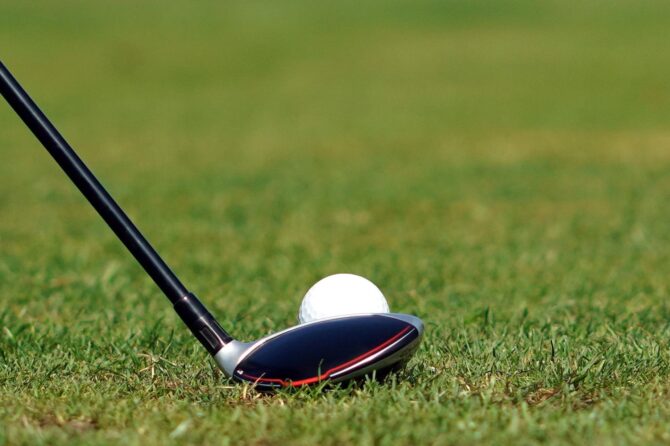Creative shots around the green can be make-or-break. Just when you think you have the jig figured out, an up-and-down becomes necessary from a foot or two off the putting surface. If you’re like us, you’ve worked on your flop shots, pitch shots, and bump-and-runs, but something’s still missing. This five-minute drill can help.
Scoring Drills: Enhancing Your Creativity
Golfers Make the Pin a Bulls-Eye Target With Score Drills
One of the best ways to sharpen your short game is to make the standard target—the pin—a bulls-eye.
When you narrow your target by visualizing a smaller one, you will begin to dial in your precision when chipping and putting. In this drill, golfers will focus on directing their chips and putts to a smaller hole that’s cut inside the regular hole.
Small Hole, Smaller Margin
Playing this drill on a practice green first involves cutting a smaller hole within the standard hole. The smaller hole should have a diameter of about 2 inches, while the regulation-size hole is 4 1/4 inches in diameter. Using a hole cutter, cut a small circle out of the existing hole. Place the smaller cup (2-inch hole) inside the larger cup (4 1/4-inch hole).
Now, start chipping and putting to the small hole. The smaller target will make it harder to make the ball, but this challenge will help improve accuracy. For example, if the target were a 12-foot putt to the small hole, it requires greater accuracy than a putt to a 12-foot hole.
Accuracy Under Pressure
This drill is perfect for simulating pressure-packed situations on the course. When playing from 100 yards and in, players need to make precise chips and putts on short notice. The skills cultivated in this drill will become second nature during the heat of competition.
Drill Tips
Use a variety of clubs, from wedges to putters.
Gradually decrease the size of the small hole over time.
* Focus on making solid contact with the ball.
| Hole Size | Description |
|—|—|
| 4 1/4 inches | Regulation-size hole |
| 2 inches | Small hole (bulls-eye) |
Chipping and Putting: Precision and Finesse
Around the greens, every shot requires a different level of creativity and touch. The more shots you add to your repertoire, the more options you will be given when faced with tricky pin positions or challenging shots. Chipping and putting are the most important parts of the game, as they account for more than half of your strokes. The key to being a good short game player is to have a solid foundation in the basics and then to practice regularly. This fun drill will help you get more creative around the green.
This drill can be done with any type of club, but it is most effective with a wedge or a putter. Start by finding a spot on the practice green that has a variety of slopes and contours. Place a ball on the green and then chip or putt the ball to a hole or target.
Once you have played a few shots, try to experiment with the following variations:
Chip the ball with different club heads.
Chip the ball with different amounts of loft.
Chip the ball with different amounts of backspin.
Chip the ball to different targets with different distances and shaped shots.
The more you practice, the more creative you will become around the greens. This drill can be done alone or with a group of friends.
The variety of stances that can be used around the green allow for several different chip shots. Although the basic set up for chipping shots should be the same, the only variable is how the body will fit into the stance depending on the lie of the ball. For uphill lies, body alignment, foot position, and club selection will determine how the clubface will strike the ball which will affect the trajectory of the shot. Uphill will require a more upright lie, a more forward ball position, and an open clubface to ensure that the ball starts on the correct trajectory. Downhill chip shots, however, will require a more bent over stance, a more back ball position, and a more closed clubface in order to strike the ball on the correct trajectory.
Strategies for Better Greenside Shots
- Practice your chipping with different types of clubs. This will help you develop a feel for how each club performs, and it will also make you more versatile on the course.
- Vary your chip shots. Don’t just hit the same chip shot every time. Experiment with different shot shapes, such as high chips, low chips, and even spin chips. This will help you learn how to hit different types of shots and will also make you more adaptable on the course.
- Use your imagination. Don’t be afraid to get creative with your chip shots. Try hitting shots over obstacles, around trees, and even off of the cart path. This will help you develop a wider range of shots and will also make you more confident on the course.
| Chip Type | Description |
|—|—|
| Bounce Chip | A low, running chip shot that uses the bounce of the club to get the ball up and down quickly |
| Lob Chip | A high, soft chip shot that is used to get the ball over obstacles or to land it softly on the green |
| Spin Chip | A chip shot that uses backspin to get the ball to stop quickly on the green |
Mastering Delicate Greenside Techniques
One of the reasons for this is that many players become passive when faced with a delicate greenside shot. They simply try to lag the ball close to the hole, hoping that it will somehow find its way in. However, this approach often leads to disappointment, as the ball frequently comes up short or misses the hole altogether.
A fun drill that can help you develop a more creative touch around the green is the “Around the World” drill. This drill requires you to hit a variety of different shots from around the green. You can use any club you want, but it’s best to start with a wedge. The key is to hit the ball with different amounts of spin and different speeds.
To do the drill, start by placing a ball on the green about 10 feet from the hole. Then, hit a shot that lands on the green and rolls up to the hole. Next, hit a shot that lands on the green and spins back towards the hole. hit a shot that lands on the green and checks up quickly.
Repeat this drill until you feel comfortable hitting different types of shots around the green. As you practice, you’ll develop a better feel for how to control the spin and speed of your shots. This will give you more confidence when faced with a delicate greenside shot, and you’ll be more likely to make the putt.
Pro Tip
Here are a few additional tips for :
- Use a variety of clubs. Don’t be afraid to use different clubs for different shots around the green. A wedge is a good all-around club, but you may also want to use a putter or a sand wedge for certain shots.
- Experiment with different stances and grips. The way you stand and grip the club can also affect the way the ball comes off the club. Experiment with different stances and grips to find what works best for you.
- Practice regularly. The best way to improve your greenside play is to practice regularly. The more you practice, the better you’ll become at controlling the spin and speed of your shots.
the “Around the Green Creativity Drill” is a valuable tool for golfers of all skill levels looking to enhance their creativity and execution around the greens. By challenging players to approach the game from different angles and distances, this drill promotes the development of essential skills such as improvisation, adaptability, and shot-making precision. Whether you’re a seasoned pro or a beginner just starting out, incorporate this drill into your practice routine to unlock a wider range of options and elevate your overall greenside performance.





